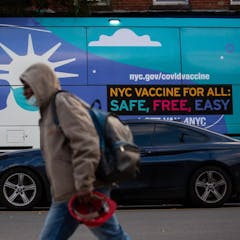
Articles on Pandemic
Displaying 461 - 480 of 1582 articles

A physician-bioethicist reflects on how health professionals are yet again facing painful reminders of the early months of the pandemic.

Vaccines and medical treatments can only go so far in an unequal society. Facing the ongoing history of racial discrimination and bias in the US would help end the pandemic.

Some vaccine hesitancy is based on a fear of the nanoparticles used in mRNA vaccines. But humans have been interacting with nanoparticles for millennia, and we use nanotechnology-based devices every day.

Last year’s COVID-19 restrictions were a relief to some people who have experienced family trauma because it spared them difficult holiday visits with relatives. Now, it’s back to holidays as usual.

Research suggests that communities need jobs, food and health care, not political acts that hijack the spirit of bayanihan.

Masks definitely catch some of the virus laden aerosols and droplets - and that will reduce transmission between people and the number of cases of COVID-19.

Supply chain issues, emergency science, social distancing requirements and a lot more free time offered both challenges and opportunities for research scientists.

Nearly all suicide-loss survivors experience guilt, wondering what they could have done to prevent it. But despite decades of research, experts struggle to identify risk factors and predict suicide.

Increased digital screen use, face masks and winter weather combine to form a triple threat to eye health: The dry eye triad. Here’s how to combat the resulting eye fatigue, irritation and discomfort.

Many scientists stuck at home during university closures dealt with increased domestic responsibilities. But some groups had it worse than others.

Shared decision-making upholds person-centred care and supports people to take charge of their own health: their views, input and experiences are important contributors to health plans.

Pediatricians and other health care providers can take some concrete steps toward building trust and counteracting anti-vaccination misinformation.

Trans people have lost access to public spaces and places, which has made it difficult for them to earn their living.

In places with low vaccination rates, COVID-19 has the chance to linger, and variants develop and travel. Without global vaccine equity, this entirely predictable pattern will repeat itself.

One of the ways the Omicron variant is different from other variants is the sheer number of mutations in the spike protein. Does this make it a super-variant?

Rapid testing for COVID-19 is an extra safety measure that can help prevent spread of infection, and help you have a more normal holiday, especially if you are visiting vulnerable people.

It was the biases of its ‘first world’ which prevented South Africa from mobilising the energies and talents of most of its people against COVID-19.

Compliance with COVID rules has been achieved in-spite of, not because of, the example set by some of those in power.

Knowing when and how often to use rapid tests is key to getting an accurate picture of your COVID-19 status.

The participation of five-to-11-year-old children in vaccination programs will make 90 per cent of the population eligible to get vaccinated against COVID-19.
